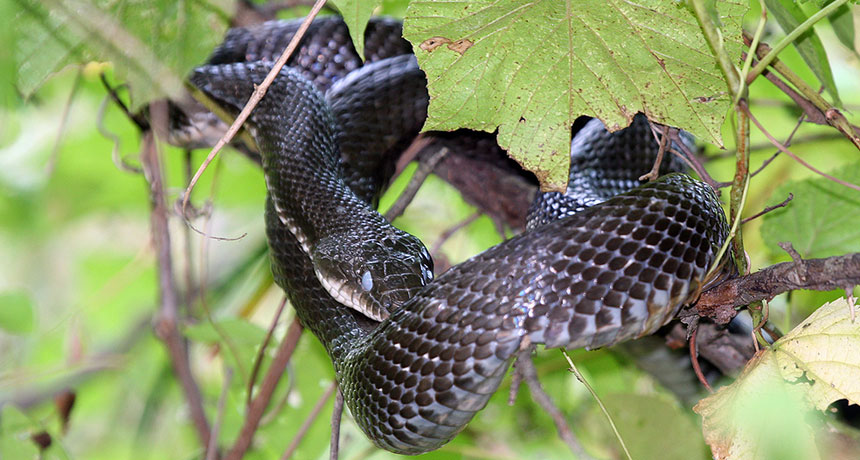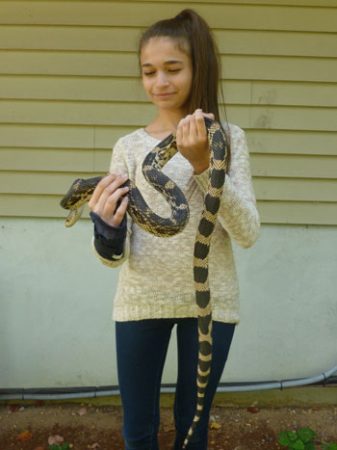Snakes go dark to soak in the sun
Serpents in the North tend to be darker than their southern cousins

This black rat snake has a dark skin that could help it heat up faster in the sun.
Sherseydc~commonswiki/CC-BY-2.0
PHOENIX, Ariz. — In the southern United States, snakes can be vibrant and bright. In the North, they tend to be dark and drab. A dark coat may seem a bit depressing. It may, however, help northern snakes soak up heat from the sun more quickly than their southern kin, a teen finds. And a quick solar heating could prove an advantage in colder climes.
Gianna Fantell, 15, presented the results of her serpentine research, here, at the Intel International Science and Engineering Fair. Created by Society for Science & the Public and sponsored by Intel, the 2016 competition, last week, brought together more than 1,750 high school students from 75 countries to share their science projects.
The freshman at Colonia High School in New Jersey has loved snakes for most of her life. “I remember I was trick-or-treating, and this woman came out [of her house] with an albino corn snake,” she recalls. Gianna instantly became fascinated with the creatures.

When it came time to design a research project for school, snakes were a natural focus. Flipping through a field guide, she noticed a pattern. “Farther north, the pigmentation of snakes is darker. As you go south, snakes are lighter,” observed Gianna. She decided to use her science project to figure out why snake colors in the North and South might vary by latitude.
Gianna looked at photos of snakes from northern and southern areas in her field guide. She selected photos of 26 snakes native to the East Coast of the United States. These snakes range from Virginia to Florida.
Gianna input the photos into a computer program and used it to analyze the colors of each snake. The computer carefully pored over 10 evenly spaced spots on each animal. From this, it computed the average brightness of each snake.
Then Gianna compared that to how far north those snakes lived. From this, the teen showed that northern snakes tend to be darker than southern ones.
Of course, geography isn’t the only factor for dark or light coloration. Bright colors also serve as a warning that some are poisonous. Others may be darker to help them blend into their surroundings. “There’s always variability,” Gianna says. “But based on the correlation and statistics, it does suggest there’s a latitudinal gradient.”
Why should that be? The teen suspected that dark snakes might be able to heat up more efficiently. This would be helpful for a cold-blooded reptile that can’t maintain its own body temperature. These animals rely on heat from the sun for warmth. In the North, temperatures are colder. So snakes may need to get as much heat as they can from the sun.
Gianna suspected that a darker snake skin might help northern snakes warm more quickly. To test that, she made eight fake snake models. These mimicked four snake species from the South and four from the North. She fashioned her models from bits of garden hose. Then she filled each with water and covered it in snakeskin that had been shed by each species. She then carefully painted the snakeskins to have the right coloration.
The teen put a temperature sensor inside each fake snake to monitor the water temperature at its core. Then, she placed her fake snakes under a 140-watt light bulb for an hour. She also placed her models in the sun for an hour at noon. This tested how well they heated with natural light.
Darker “snakes” reached a higher inside temperature than her lighter ones. On average, they were 17.7° Celsius (32° Fahrenheit) warmer. Gianna hopes that learning about how snakes stay warm might help conserve them in the future. It could help predict which might be most at risk from the global warming associated with climate change.
Power Words
(for more about Power Words, click here)
albinism (adj. albino) A genetic disorder characterized by a lack of skin pigment, making a person or animal appear very pale or even entirely white. In people, it is associated with vision problems.
climate change Long-term, significant change in the climate of Earth. It can happen naturally or in response to human activities, including the burning of fossil fuels and clearing of forests.
clime An alternative and rather casual word for climate.
cold-blooded Adjective for an animal whose body temperature varies with that of its environment.
gradient From the word “grade,” it describes the incline, slope or degree of increase in some measure (such as temperature, pressure or even color) that develops as one moves in time, position or along some scale.
latitude The distance from the equator measured in degrees (up to 90).
reptile Cold-blooded vertebrate animals, whose skin is covered with scales or horny plates. Snakes, turtles, lizards and alligators are all reptiles.
sensor A device that picks up information on physical or chemical conditions — such as temperature, barometric pressure, salinity, humidity, pH, light intensity or radiation — and stores or broadcasts that information. Scientists and engineers often rely on sensors to inform them of conditions that may change over time or that exist far from where a researcher can measure them directly. (in biology) The structure that an organism uses to sense attributes of its environment, such as heat, winds, chemicals, moisture, trauma or an attack by predators.
serpentine Relating to serpents or snakes.
Society for Science and the Public (or SSP) A nonprofit organization created in 1921 and based in Washington, D.C. Since its founding, SSP has been not only promoting public engagement in scientific research but also the public understanding of science. It created and continues to run three renowned science competitions: The Intel Science Talent Search (begun in 1942), the Intel International Science and Engineering Fair (initially launched in 1950) and Broadcom MASTERS (created in 2010). SSP also publishes award-winning journalism: in Science News (launched in 1922) and Science News for Students (created in 2003). Those magazines also host a series of blogs (including Eureka! Lab).
species A group of similar organisms capable of producing offspring that can survive and reproduce.







